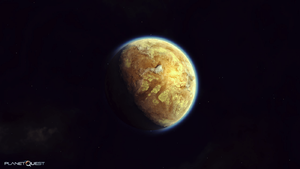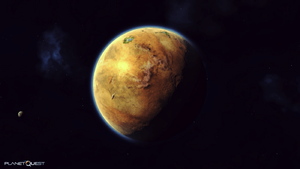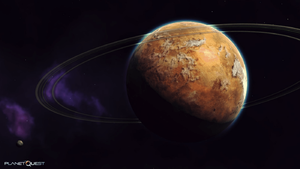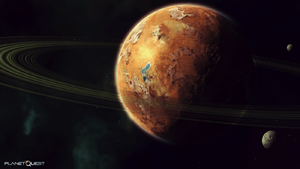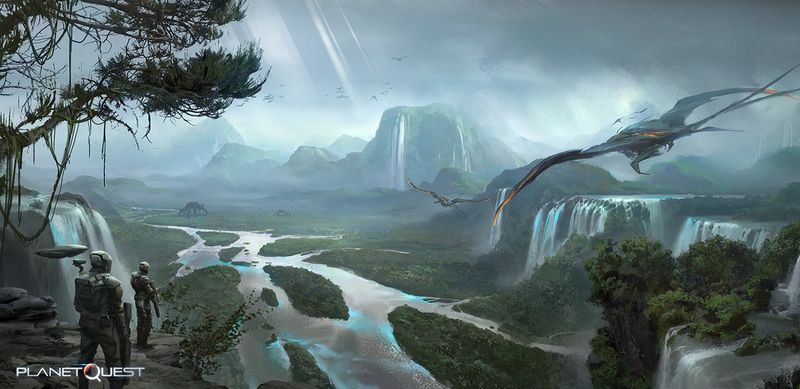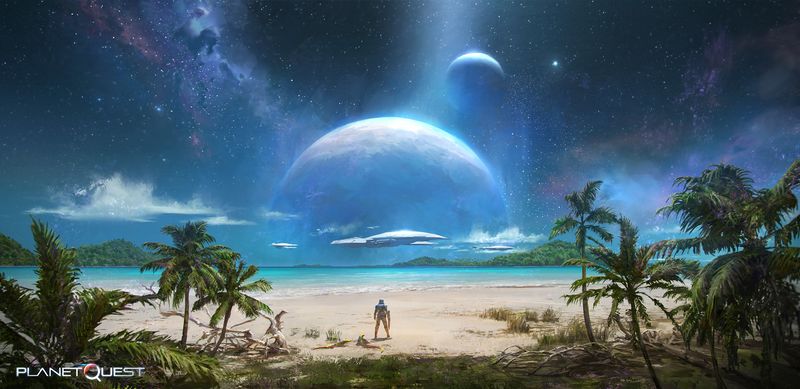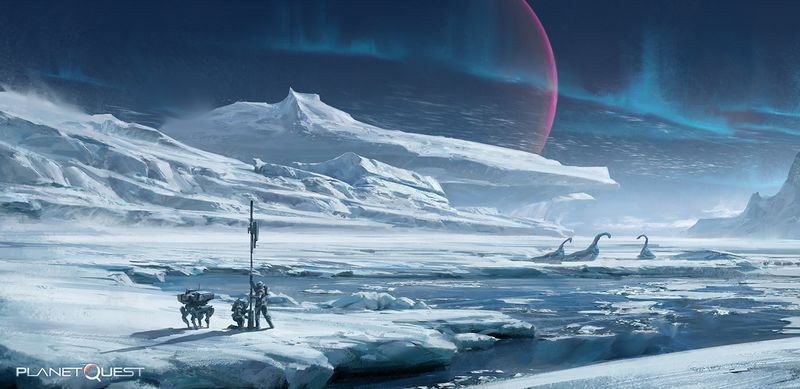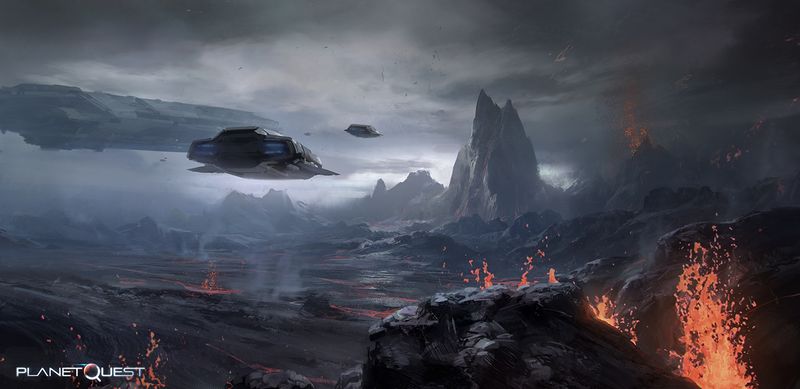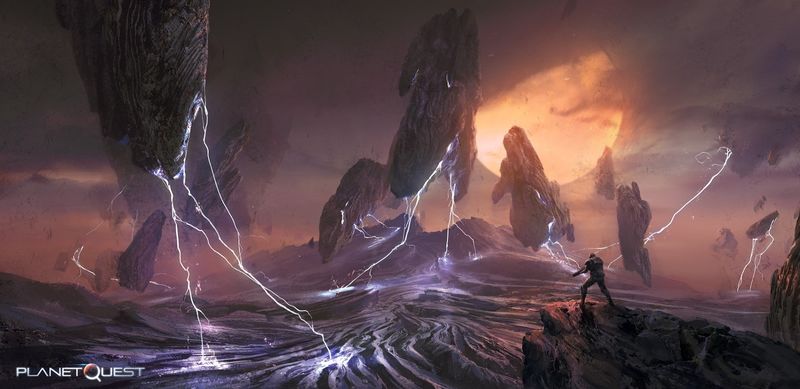Genesis Engine
What is the Genesis Engine?
"We are creating a reality better than reality"
One of the questions that lie at the foundation of PlanetQuest is this: wouldn’t it be amazing if you could own an entire planet?.
With this vision the PlanetQuest team decided to create a system that is capable of procedurally generating entire planets. Galactic Entertainment’s Genesis Engine is capable of procedurally generating and rendering entire planets from orbit. This technology is powerful enough to allow us to terraform entire planets with the ease of pulling a slider and will soon allow players to descend to a similarly generated planet surface - planets that not only look beautiful and realistic, but also actually follow the laws of nature. Moreover, these planets were not supposed to be a simple picture on a screen. They should be generated in full 3D, so that we can admire them from every angle and see the effects of nearby stars and other light sources. Finally, everything about the planets should make them real and alive, they were not supposed to be static. After a lot of hard work, the Genesis Engine was born.
The Genesis Engine can generate beautiful planets directly in your browser. Each planet we generate is completely unique and all of its intricate details are interlinked. The temperature on the planet dictates whether or not the planet will have polar caps. The amount of water correlates to the number of clouds that slowly move over the planet as well as the size of possible forests and other types of vegetation. The Genesis Engine plays with all the little details that can differ between planets and uses that to create planets in full 3D that are completely distinct from one another, yet completely follow natural laws.
PlanetQuest's developers have spent many hours searching for the perfect texture to give to our planets. They have experimented with relief, shadows, the interplay between the nebula behind the planet and the color of the atmosphere and every other little detail you can think of. Of course, this is only the tip of the iceberg of the capabilities of the Genesis Engine. Although every planet is completely unique, team has developed four distinct classes of planets based on their rarity.
Just have a look at one of the first revealed planets below. Looks great, isn't it?
"The Genesis Engine — A fictional reality brought to life"
Each of our planets follows fundamental laws of physics akin to the ones on our world. Each planet, like our own, adheres to Rayleigh Scattering, a phenomena explaining the scattering of light waves when entering an atmosphere and its subsequent effects on perceived color. As light oscillates and excites smaller atmospheric molecules it scatters in a multi-directional pattern emitting a different color based on the wavelength of the light. Furthermore, planets and their moons have differences in relative positioning and orbit speed based on their mass and thus gravitational pull.
Aligning with both science fiction and principles of physics our Genesis Engine intentionally respects laws of physics both as an educational tool but also masks a more humbling truth. We are at the mercy of the elements. Our curiosity in the face of space unknown has now given birth to a scientific mandate: understand the stars and the rules governing all that is between them. It is now more apparent that we survive through what we understand, and we understand through what we explore.
How does it work?
An Entire World from the Smallest Texture
The powerful procedural generation of planets is made possible by our Genesis Engine, underpinned by randomized textual algorithms. These algorithms create distinct, stylistic planets adhering to various base textures and classes.
The Genesis Engine uses texture synthesis algorithms to digitally construct planet planes, each with its own texture and pattern intricacies. These textures are designed by our in-house artists, to create hundreds of variations of planet landscapes in 3D, that reflect and align to its planet class. Traditionally, these synthesis algorithms are used for post-production in films, image editing, and more. By pushing the barriers of innovation, the Genesis Engine optimizes this algorithm and augments it for a 3D environment.
This in-house decal algorithm takes each of these textured planes, positioned at different angles which gradually contact the base planet. Upon this contact, it imposes a piece of the texture onto the planet based on the randomized noise on its surface. This elegant imposition gives each planet its own unique flair and construction, different from every other planet.
Finally, each unique generation of a planet is embedded into a single seed number, containing all of the planet’s metadata. This number allows us to reproduce the exact randomization of each planet anywhere and at any time.
The Genesis Engine utilizes these algorithms to achieve hyperrealism. A strong representation of what is possible when applying passion and motivation to push limits of physical innovation. The human obsession with space and science fiction has blurred boundaries as we strive to understand space, stars, and everything in between. With the power of creation in our hands, we can now design by carving a slice of infinity, explore its depths, and take over what lies in the unknown.
Perception is all About Light
As part of our desire to adhere to the realism of the universe both from an educational and immersive perspective, we capture various lighting features to fascinate the human sense of sight.
We use physically based rendering (PBR) models, to achieve this photorealistic appeal. These PBR models allow us to formulate mathematical rendering equations which contribute to the consistency of planet and moon creation. Practically, this means that regardless of your perspective, planet surface ruggedness, coloring, and class-specific features all render consistently with the position of the light in mind. Unbelievably, this meticulous balancing of shadows and light creates the rugged surface textures that are seen on each and every planet in a reproducible manner.
One of the Ice Planet’s defining features would be the subsurface scattering which reinforces the vivid ice imagery. Almost all objects in real life are not entirely opaque at the surface level, and as such have some degree of translucency that light can penetrate and then be bounced off. This absorbing and subsequent bouncing is known as subsurface scattering, which diffuses the absorbed light at different angles upon exiting the object, defining how we perceive objects in our world. Capturing this effect is key in the world of 3D applications as it enables a photorealistic effect. Since ice is completely translucent in nature, it was imperative that we capture these effects through careful adjustments and experimentations to best express the natural grandeur of ice and glaciers. Through these vivid depictions, we have developed our own artistic interpretation of ice’s appearance, combining features from our real-world with hints of fantasy.
The Genesis Engine utilizes these models and manipulation of light to immerse Explorers into our sci-fi-inspired cinematic multiverse whilst capturing photorealistic familiarities of our world. Our philosophy of challenging reality and blurring the boundaries between our world and others has led us to develop familiar landscapes and subvert the human experience to one revered by science fiction.
Perlin Noise, The Driving Force Behind Texture Generation
Another key feature of our Genesis Engine by shining a spotlight on the technology that empowers our use of randomized textual algorithms.
Perlin noise is a gradient noise algorithm developed for the procedural generation of object textures in the early 1980s by Ken Perlin. It has seen use in many media productions across motion pictures and gaming over the last forty years, from 1982’s Tron to Minecraft. Perlin noise is widely used to recreate patterns from nature: elements such as clouds, mountain ranges, forest expanses, and, relevant to today’s reveal, fire, lava, the myriad topographical features you may expect to encounter on a volcanic planet.
We utilize this technology by deploying multiple textured three-dimensional planes which are absorbed by the planet’s surface, itself constructed by the aggregation of multiple Perlin noises.
Our talented developers employ Perlin noise to create worlds at once familiar and distinct from one another. Combining this algorithm with the rest of the Genesis Engine’s toolkit allows our team to bring truly unique-looking planets to life. The end goal? To keep to our design philosophy of creating a reality better than reality.
The Higher Purpose
The Genesis Engine is capable of procedurally generating and rendering entire planets while also following the principles of real-world physics and the laws of nature. By infusing our own creative vision of an ever-expanding cinematic multiverse, The Genesis Engine is powered by the natural grandeur of reality mixed with fantasy.
In real-world, the increased humidity of the Forest Planet leads to more cloud formations. The spectrum of temperature is also causing various physical adaptations by flora and fauna alike to survive and thrive. All these natural parameters along with other intricacies will shape the ecosystem and give life to each individual planet.
PlanetQuest’s Genesis Engine is designed in a way that mirrors reality, capturing the vastness and beauty of our galaxy yet to be explored by man. By igniting the curiosity for the known and unknown, we can raise awareness and kindle a movement towards caring for our own planet. We can pave the way to inspire generations of children and adults to cherish our earth while experiencing all the amazing things space has to offer us.
